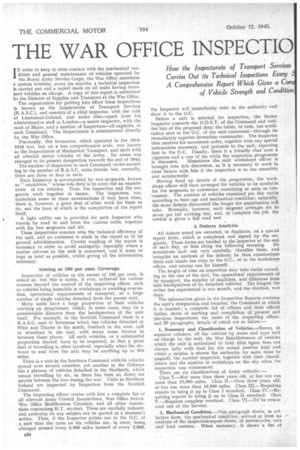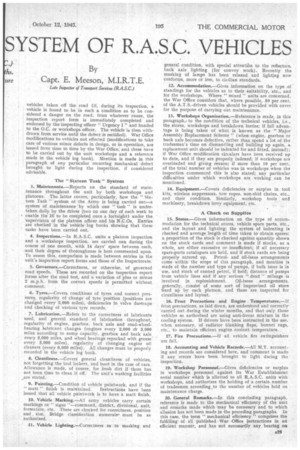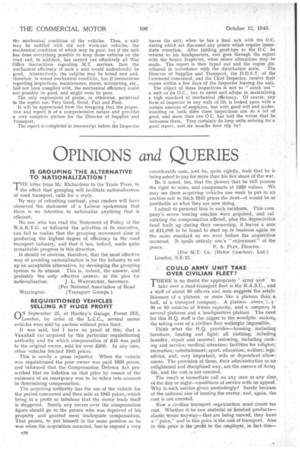THE WAR OFFICE INSPECTIO SYSTEM OF R.A.S.C. VEHICLES
Page 26

Page 27

Page 28

If you've noticed an error in this article please click here to report it so we can fix it.
How the Inspectorate of Transport Services Carries Out its Technical Inspections Every A Comprehensive Report Which Gives a Corn of Vehicle Strength and Condition
By Capt. E. Meeson, M.I.R.T.E.
Late Inspector of Tranoort Services (R.A.S.C.) IN order to keep in close contact with the mechanical condition and general maintenance of vehicles operated by the Royal Army Service Corps, the War Office maintains a system whereby, every six months, a technical inspection is carried out and a report made on all units having transport vehicles on charge. A copy of this report is submitted to the Director of Supplies and Transport at the War Office.
The organization for putting into effect these inspections Is known as the Inspectorate of Transport Services (R.A.S.C.), and consists of a chief inspector, with the sank of Lieutenant-Colonel, and under him—apart from his administrative staff in London—a senicir inspector, with the rank of Major, and a number of Inspectors—all captains, in each Command. The Inspectorate is administered directly by the War Office.
Previously, this formation, which operated in the 19141918 war, but on a less comprehensive scale, was known as the Inspectorate of Mechanical Transport, and dealt with all wheeled motor vehicles of the Army. Its name was changed to its present designation towards the end of 1943.
The number of inspectors in each Command varies according to the number of R.A.S.C. units therein, but, normally, there are three to four in each.
Each Inspector is accompanied by two sergeants, known as " examiners," whose sole duty is to carry out an examination of the vehicles. Thus, the inspectors and the sergeants work together in teams. The inspectors, too, undertake some of these examinations if they have time; there is, however, a great deal of other work for them to do, not the least of which is the compilation of the report itself.
A light utility car is provided for each Inspector who travels by road to and from the various units, together with his two sergeants and kit.
. These inspections concern only the technical efficiency of the unit, and no comment is made in the report as to its general administration. Careful worsting of the report is necessary in order to avoid ambiguity, especially where a matter adverse to the unit is concerned, and it most be kept as brief as possible, whilst giving all the information necessary.
Aiming at 100 per cent. Coverage Inspection of vehicles to the extent of 100 per cent. is aimed at, but this is rarely, if ever, achieved for various reasons beyond the control of the inspecting officer, such as vehicles being immobile in workshops or awaiting evacaation, operational requirements of transport, or a large number of single vehicles detached from the parent unit.
Many units have a large proportion of their vehicles working on detachment, which; in some cases, may be a considerable distance from the headquarters of the unit itself. For example, in the Scottish Command there is a R.A.S.C. unit at Inverness which has vehicles detached at Wick and Thurso in the north, Gairloch in the west, apff at Aberdeen in the east, with many more located in between these places. All such vehicles, or a substantial proportion thereof, have to be inspected, so that a great deal of travelling is often involved, especially when the distance to and from the unit may be anything up to 200 miles.
There is a unit in the Southern Command with its vehicles spread over several counties; yet another in the Orkneys has a platoon of vehicles detached in the Shetlands, which means travelling by air, as there has been no direct sea service between the two during the war. Units in Northern Ireland are inspected by Inspectors from the Scottish Command. .
The inspecting officer carries with him a complete list of all relevant Army Council Instructions, War Office letters, War Office Modification Circulars, and all other instructions concerning M.T. matters. These are carefully indexed, and authority on any subject can be quoted at a moment's notice. Thus, if the Inspector points out to the O.C. of a unit that the tyres on his vehicles are, in error, being changed around every 5,000 miles instead of every 2,000, the Inspector will immediately refer to the authotity and show it to the O.C.
Before a unit is selected for inspection, the Senior Inspector contacts the D.D.S.T. of the Command and notifies him of the proposed date; the latter, in turn, has notification sent to the O.C. of the unit concerned—through its immediately superior formation commander. The Inspector then receives his movement order, together with any special instructions necessary, and proceeds to the unit, reporting first to the O.C. Usually, there is a friendly chat over a cigarette and a cup of tea while the inspection programme is discussed. Sometimes the ..unit workshops officer is brought into this discussion, as it is necessary to work in close liaison with him if the inspection is to run smoothly and satisfactorily,
Having fixed up details of the programme, the workshops officer will have arranged for vehicles to be available for the sergeants to commence examining as soon as convenient. The number of vehicles examined per day varias according to their age and mechanical condition; naturally, the more defects discovered the longer the examination will take. Normally, however, each sergeant averages six to seven per full working day, and, tp complete the job, the vehicle is given a full road test.
A Defects Analysis All defects noted are recorded, in duplicate, on a special report form, which is completed and signed by the sergeants. These forms are handed to the inspector at the end of each day, or first thing the following morning. He scrutinizes each one very carefully, classifies them, and 'compiles an analysis of the defects; he then countersigns them and hands one copy to the 0.C., or to the workshops officer, and retains one for himself.
The length of time an inspection may take varies according to the size of the unit, the !operational requirements of its transport, the number of machines, and distances from unit headquarters of its detached vehicles. The longest the writer has experienced is one month, and the shortest, two days.
The information given in the Inspection Reports contains the unit's designation and location; the Command in which it is located; a complete list of officers and their official duties; dates of starting and completion of present and previous inspections; the name of the inspecting officer, and 20 paragraphs, details of which are as follow; 1. Summary and Qassification of Vehicles—Shows, in separate columns, all the vehicles by make and type held on charge by the unit, the War Establishment of vehicles which the unit is authorized to hold (this figure does not always tally with that for the actual number held and where a surplus is shown the authority for same must be queted), the number inspected, together with their classification and the number in workshops on the day when the inspection was commenced.
There are six classifications of Army vehicles:— Class1.—Not more than three years old, or has not run more than 10,000 miles. Class IL—Over three years old, or has run more than 10,000 miles. Class III.—Requiring repairs to bring it up to Class I standard. Class IV.—Requiring repairs to bring it up to Class II standard. Class V.—Requires complete overhaul. Class VI.—ToThe evacuated out of the Service.
2. Mechanical Condition.—This paragraph shows, in collective form, the mechanical condition, arrived at from an analysis of the inspection-report forms, of motorcycles, cars and toad carriers. When necessary, it shows a list of vehicles taken off the road (if, during its inspection, a vehicle is found to be in such a condition as to be considered a danger on the road, from whatever cause,, the inspection report form is immediately completed and endorsed by the inspecting officer " Urgency " and handed to the 0.C. or workshops officer. The vehicle is then withdrawn from service until the defect is rectified). War Office modifications tovehicles not effected (modifications to take care of various minor defects in design, or in operation, are issued from time to time by the War Office, and these have to be carried out by the unit workshops and a reference made in the vehicle log book). Mention is made in this paragraph of any particular recurring mechanical defect brought to light during the inspection, if considered advisable.
The "Sixteen Task" System 3. Maintenance.—Reports on the standard of maintenance throughout the unit by both workshops and platoons. The latter covers, particularly, how the " Sixteen Task " system of the Army is being carried out—a system of maintenance 'by which one " task " is undertaken daily by the driver (two on one day of each week to enable the 16 to be completed once a fortnight) under the supervision of the platoon officer and his N.C.0s. Entries are checked in the vehicle Jog books showing that these tasks have been carried out.
4. Inspections.—In R.A.S.C. units a platoon inspection and a workshops inspection, are carried oui). during the course of one month, with 14 days' space between each, and their degree of thoroughness is here commented upon. To assess this, comparison is made between entries in the unit's inspection report forms and those of the Inspectorate.
5. Governors.—Correctness, or otherwise, of governed road speeds. These are recorded on the inspection report forms after the road test, and a variation of plus or minus 2 m.p.h. from the correct speeds is permitted without comment; .
6. Tyres.—Covers conditions of tyres and correct pressures, regularity of change of tyre position (positions are changed every 2,000 miles), deficiencies in valve dustcaps and checking of various tyre records.
7. Lubrication.—Refers to the correctness of lubricants used, and general standard of lubrication throughout, regularity of engine, gearbox, back axle and road-wheelbearing lubricant changes (engines every 2,000 dr 3,000 miles according to sump capacity, gearbox and back axle, every 5,000 miles, and wheel bearings repacked with grease" every 5,000 miles), regularity of changing engine oil cleaners (every 6,000 miles). All changes must be properly recorded in the vehicle log book.
8. Cleanliness.—Covers general cleanliness of vehicles, not forgetting the tool lockers, and boot in the case of cars. Allowance is made, of course, for fresh dirt if there has not been time to clean it off. The unit's washing facilities _are stated.
9. Painting.—Condition of vehicle paintwork, and if the " matt " finish is maintained. Instructions have been issued that all vehicle paintwork is to have a matt finish.
10. Vehicle Marking.—All army vehicles carry certain markings or " signs "—command, district, divisional, unit, formation, etc. These are checked for correctness, position and . size. Bridge classification numeralsmust he as authorized.
11. Vehicle Lighting:—Correctness as to masking and general condition, with special attentibn to the reflectors, back axle lighting (for convoy work). Recently the masking of lamps has been relaxed and lighting now conforms, more or less, to civilian standards.
12. Accommodation.—Gives information on the type of standings for the vehicles as to their suitability, etc., and for the workshops. Where " mixed " units are concerned, the "War Office considers that, where possible, 50 per cent. of the A.T.S.-driven vehicles should be provided with cover for the purpose of carrying out maintenance.
13. Workshops Organization.—Reference is made, in this paragraph,to the condition of the technical vehicles, i.e., the stores, workshops and breakdown lorries; if full advantage is being taken of what is known as the "Major Assembly Replacement Scheme " (when engine, gearbox or back axle becomes defective, rather than spend a lot of the tradesmen's time on dismantling and building up again, a. replacement unit should be indented for and fitted, instead); if War Office modification circulars have been received up to date, and if they are properly, indexed; if workshops are overloaded and giving reason; if more than 10 per cent. of the total number of vehicles was in workshops when the inspection commenced this is also stated; any particular difficulties under which workshops are working can be mentioned.
14. Equipment.—Covers deficiencies or surplus in toot kits, wireless suppressors, tow ropes, non-skid chains, etc., and their condition. Similarly, workshop tools and machinery, breakdown lorry equipment, etc.
A Check on Supplies 15. Stores.—Gives information on the type of accommodation for the technical stores, vehicle spare parts, etc., and the layout and lighting; the system of indenting is checked and average length of time taken to obtain spares; a proportion of the stock is checked against quantity shown on the stock cards and comment is made if stocks, as a whole, are either excessive or insufficient; if all necessary spare-parts catalogues are held, and if stock cards are being properly entered up. Petroland oil-issue arrangements come within the scope of this paragraph, and mention is made of the number and type of pumps, if bulk issue is in use, and stock of canned petrol, if held; distance of pumps from vehicle lines and if any serious " dead " mileage is involved in replenishment. Oil-issue arrangements, generally, consist of some sort of improvised oil store fixed up by each platoon, and these are inspected for cleanliness and layout.
16. Frost Precautions and Engine Temperatures.—IF frost precautions, as laid down, are understood and correctly 'carried out during the winter months, and that only those vehicles so authorized are using anti-freeze mixture in the cooling system. If drivers have been instructed in the use, when necessary, of radiator blanking flaps, bonnet rugs, etc, to maintain efficient engine coolant temperature.
17. Fire Precautions.—If all vehicle fire extinguishers are full.
18. Accounting and Vehicle Records.—All M.T. accounting and records are considered here, and comment is made if any errors have been brought to light during the Inspection.
19. Workshop Personnel.—Gives deficiencies or surplus in workshops personnel against its War Establishment serial number which is allotted to all R.A.S.C. units with workshops, and authorizes the holding of a certain number of tradesmen according ,to the number of. vehicles held on maintenance charge.
20. General Remarks.—In this concluding paragraph, reference is made to the mechanical 'efficiency of the unit and remarks made which -may be necessary and to which allusion has not been made in the preceding paragraphs. In this case, the term " mechanical efficiency " comprises the fulfilling of all published War Office instructions in an efficient manner, and has not necessarily any, bearing on the mechanical condition of the vehicles. Thus, a unit may be saddled with old and worn-out vehicles, the mechanical condition of which may be poor, but if the unit has done everything possible to keep those vehicles on the road and, in addition, has carried out effectively all War Office instructions regarding M.T. matters, then the mechanical efficiency of such a unit would undoubtedly be good. Alternatively, the vehicles may be brand new and, therefore, in sound mechanical condition, but if instructions regarding inspections maintenance, stores, accounting, etc., had not been complied with, the mechanical efficiency could not possibly be good, and might even be poor.
The only expressions of praise, or otherwise, permitted in the report are: Very Good, Good, Fair and Poor.
It will be appreciated from the foregoing that the inspection and report is of a comprehensive nature and provides a very complete picture for the Director of Supplies and Transport.
The report is completed in manuscript before the Inspector leave the unit, when he has a final talk with the O.C. during which are discussed any points which require immediate attention. After bidding good-bye to the O.C. he returns to his headquarters, and goes through the report with the Senior Inspector, when minor alterations may be made. The report is then typed out and the copies dis
tributed in accordance with the distribution scale. The Director of Supplies and Transport, the D.D.S.T. of the Command concerned, and the Chief Inspector, receive their copies within a few days of the Inspector leaving the unic.
The object of these inspections is not to " catch out" a unit or its 0.C., but to assist and advise in maintaining a high standard of mechanical efficiency. Of course, any form of inspector in any walk of life is looked upon with a certain amount of suspicion, but with good will and understanding on both sides these inspections can do a' lot of good, and more than one O.C. has told the writer that he welcomes them. They certainly do keep units striving for a good report, and six months soon slip by!




















































